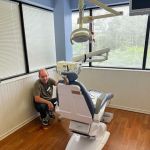- 1-understanding-deep-cleaning-and-its-effects-on-gums
- 2-common-symptoms-and-gum-sensitivity-after-deep-cleaning
- 3-effective-home-care-tips-for-healing-gums
- 4-nutritional-and-lifestyle-factors-for-gum-recovery
- 5-when-to-see-a-dentist-during-the-healing-process
- 6-patient-stories-on-recovery-after-deep-cleaning
- 7-recommended-products-for-gum-care-from-dentistry-toothtruth
1. Understanding Deep Cleaning and Its Effects on Gums
Deep cleaning, also known as scaling and root planing, is a dental procedure aimed at removing plaque and tartar buildup below the gumline to treat gum disease. While effective, it can cause temporary gum irritation, soreness, and minor bleeding.
These effects result from the removal of bacterial deposits and smoothing of root surfaces, allowing gums to reattach to teeth. The healing process is crucial for reversing periodontal disease and maintaining oral health.
Understanding how deep cleaning impacts your gums prepares you for the recovery journey and emphasizes the importance of following post-procedure care instructions.
2. Common Symptoms and Gum Sensitivity After Deep Cleaning
After a deep cleaning, it’s common to experience gum tenderness, swelling, and mild bleeding. Sensitivity to hot or cold foods may occur, along with slight discomfort while brushing or flossing.
These symptoms generally subside within a few days to a couple of weeks as the gums heal. However, persistent or severe pain may indicate complications and should prompt a dental consultation.
Recognizing these typical post-treatment symptoms helps reduce anxiety and encourages adherence to healing protocols.
3. Effective Home Care Tips for Healing Gums
Proper home care accelerates gum healing after deep cleaning. Gentle brushing with a soft-bristled toothbrush and using antimicrobial mouth rinses can reduce inflammation and prevent infection.
Avoiding tobacco, alcohol, and hard or spicy foods protects sensitive gum tissue. Warm saltwater rinses soothe discomfort and promote tissue repair.
Maintaining excellent oral hygiene by flossing carefully and following your dentist’s instructions ensures a clean environment for gums to regenerate.
4. Nutritional and Lifestyle Factors for Gum Recovery
Nutrition plays a key role in gum healing. Consuming foods rich in vitamins C and D, calcium, and antioxidants supports tissue repair and immune function.
Hydration is essential to maintain saliva production, which protects oral tissues. Stress management and adequate sleep also contribute to efficient healing.
Adopting a healthy lifestyle with balanced diet and proper rest complements dental care and speeds recovery.
5. When to See a Dentist During the Healing Process
If you experience severe pain, swelling that worsens, persistent bleeding, or signs of infection such as fever, contact your dentist promptly.
Follow-up visits allow your dentist to monitor healing progress and intervene if necessary. Early detection of complications can prevent further issues and ensure optimal recovery.
Staying in close communication with your dental care provider is essential during the healing period.
6. Patient Stories on Recovery After Deep Cleaning
Jane, a 38-year-old patient, shared how following gentle brushing and saltwater rinses helped her soothe gum soreness after deep cleaning. She emphasized the importance of patience and consistency during the healing process.
Another patient, Mark, reported initial discomfort but noted that adhering to his dentist’s advice and avoiding certain foods led to full recovery within two weeks.
These stories provide reassurance and practical insights for others undergoing similar treatments.
7. Recommended Products for Gum Care from Dentistry Toothtruth
Dentistry Toothtruth offers a range of trusted products to support gum healing after deep cleaning, including antiseptic mouthwashes, soft-bristle toothbrushes, and nutrient supplements tailored for oral health.
Their expert recommendations help patients select effective, gentle products that complement professional dental care, enhancing comfort and accelerating recovery.
Explore Dentistry Toothtruth’s resources to find the best solutions for your gum care needs.







 Kremers, Forbes and Associates DDS5.0 (689 review)
Kremers, Forbes and Associates DDS5.0 (689 review) Dental Care of Sumner: Scott Crane, DDS5.0 (5 review)
Dental Care of Sumner: Scott Crane, DDS5.0 (5 review) Isthmus Dental, Ltd4.0 (215 review)
Isthmus Dental, Ltd4.0 (215 review) SOUTHWEST SMILES LAS CRUCES5.0 (1 review)
SOUTHWEST SMILES LAS CRUCES5.0 (1 review) Ocean Pediatric Dental Associates4.0 (411 review)
Ocean Pediatric Dental Associates4.0 (411 review) Gentle Dental4.0 (210 review)
Gentle Dental4.0 (210 review) The Importance of Oral Health Education During Pregnancy for a Healthy Pregnancy
The Importance of Oral Health Education During Pregnancy for a Healthy Pregnancy Best Tips for Brushing Your Teeth Properly for Healthy Gums: Essential Techniques for Oral Health
Best Tips for Brushing Your Teeth Properly for Healthy Gums: Essential Techniques for Oral Health Why Skipping Dental Checkups Can Lead to Bigger Oral Health Problems
Why Skipping Dental Checkups Can Lead to Bigger Oral Health Problems Advantages of Porcelain Dental Restorations
Advantages of Porcelain Dental Restorations How Can Diabetes Cause Tooth and Gum Problems? Preventing and Managing Oral Health Issues
How Can Diabetes Cause Tooth and Gum Problems? Preventing and Managing Oral Health Issues Healthy Habits for Promoting Good Oral Health and Hygiene: Tips for a Healthy Smile
Healthy Habits for Promoting Good Oral Health and Hygiene: Tips for a Healthy Smile